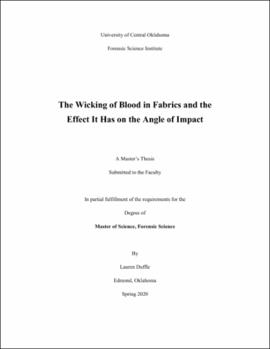| dc.contributor.author | Duffle, Lauren | |
| dc.date.accessioned | 2021-09-14T20:36:52Z | |
| dc.date.available | 2021-09-14T20:36:52Z | |
| dc.date.issued | 2020 | |
| dc.identifier.uri | https://hdl.handle.net/11244/330807 | |
| dc.description.abstract | Bloodstain pattern analysis (BPA) is currently limited to smooth, non-porous surfaces. The purpose of this study was to determine whether the same mathematical model used to analyze bloodstain patterns on smooth, non-porous surfaces can be used to analyze bloodstains on non-smooth, porous surfaces (fabrics). This study used a control surface (poster board) and two fabric types, 100% cotton fabric and 98% cotton and 2% spandex fabric. Drops of non-coagulated pork blood were deposited onto all three surfaces at varying angles from 10 to 90 degrees at 10 degree increments, and the resulting bloodstains were measured using digital calipers and a drafting divider. A statistical analysis was done on the measurements using ANCOVA to test for differences between the mean absolute differences of the angles with respect to type of surface and actual angle, and Tukey’s multiple comparisons was used when appropriate. The results showed that the same mathematical model used for smooth non-porous surfaces could be used to determine the angle of impact (AOI) for both fabrics tested, with a variance of no greater than +/- 5°. This could prove invaluable as a means of advancing the field of BPA. | en_US |
| dc.rights | All rights reserved by the author, who has granted UCO Chambers Library the non-exclusive right to share this material in its online repositories. Contact UCO Chambers Library's Digital Initiatives Working Group at diwg@uco.edu for the permission policy on the use, reproduction or distribution of this material. | |
| dc.title | The Wicking of Blood in Fabrics and the Effect It Has on the Angle of Impact | en_US |
